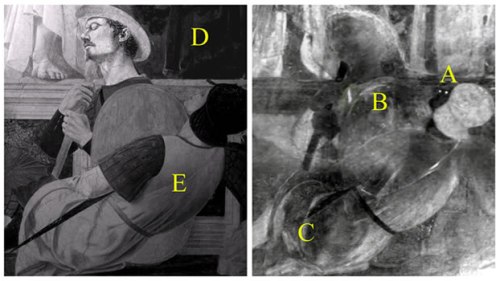A new imaging tool has been developed by Italian researchers which is capable of capturing features that could not be detected with existing imaging methods or with the naked eye. Utilizing the reflected light from the spectrum’s mid-infrared portion, the Thermal Quasi-Reflectography (TQR) system is capable of producing sharper and better contrast images.
 "The Resurrection" by Piero della Francesca: NIR image (left) and TQR image (right). A retouches; B inhomogeneities on the shield; C Different execution techniques on the soldier’s sword, not detected in NIR; D better differentiation of the background in MWIR; E different reflectance NIR MWIR.
"The Resurrection" by Piero della Francesca: NIR image (left) and TQR image (right). A retouches; B inhomogeneities on the shield; C Different execution techniques on the soldier’s sword, not detected in NIR; D better differentiation of the background in MWIR; E different reflectance NIR MWIR.
Scientists from the University of Verona, University of L’Aquila, and the National Institute of Optics in Florence, Italy, have illustrated the application of TQR system on two popular artworks, ‘The Resurrection’ by Piero della Francesca and the Zavattari frescos in the Chapel of Theodelinda. In the former painting, the TQR system revealed some interesting details. For instance, a soldier’s sword was painted by utilizing two different fresco methods, and highly reflective retouches were made during the restoration process. Such slight differences were not identified by near-infrared (NIR) photography. In the latter painting, the TQR system exposed features that were not identified by previous near-infrared and optical techniques. The system was able to identify restoration techniques wherein gold decorations have been repainted.
The standard infrared imaging method, thermography, can detect slight temperature variations as a result of pigmentation on the painting’s surface. Such thermal maps can be utilized to restore faded and damaged works of art to expose the internal flaws, which are not apparent in visible light. On the other hand, the TQR imaging system employs a different method. Instead of detecting the heat produced from paintings, it attempts to reduce it. A mid-infrared light source is directed on the painting’s surface by the TQR imaging system, which then captures the light that gets reflected back to a camera.
According to Dario Ambrosini, one of the paper’s authors, this is the first time that such a method has been used on artworks and signifies a powerful tool for investigation and preservation of artworks.
Tests are being conducted to find out whether the TQR system can also determine the chemical composition of the pigments which is vital in preserving and restoring the artwork.
The research paper titled “Thermal Quasi-reflectography: a new imaging tool in art conservation" was published in the Optical Society’s journal, Optics Express.
Source: http://www.osa.org/